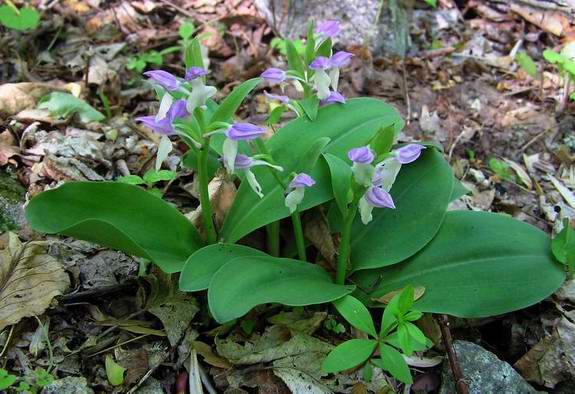|
Return to Hiker's Notebook Home Page
Common Name: Showy Orchis, Purple-hooded orchis, Gay orchis - The flower was originally assigned to the genus Orchis by the taxonomist Carolus Linnaeus, the contrasting purple and white blossoms distinguish it as "showy" compared to the other temperate orchids.
Scientific Name: Galearis spectabilis - The generic name is from the Latin galea, meaning helmet; the purple upper petal provides a metaphorical helmet to the white lower petal. Spectabilis means "worth seeing" or "remarkable" in Latin. It is also frequently listed as Orchis spectabilis.
Orchidaceae is the largest family of the flowering plants; estimates of its size range from 20,000 to 50,000 species according to the degree of diversity assumed for the plethora of tropical provenance. The orchids are taxonomically assigned due to the presence of several morphologies that most individual species display. They are tripartite, having three sepals (the outer sheath of the flower bud) and three petals, all of which are often brightly colored. They are zygomorphic in having bilateral symmetry; the left and right sides are mirror images. They have a unitary reproductive structure called a column with the female pistil at the bottom and the (usually) single male stamen at the top dispensing pollen is a singular mass called a pollinia. They have an undifferentiated embryo in a miniscule seed that contains scant endosperm, the starchy nutrient that most plants provide to sustain nascent growth. The success of the family is attributable to the adaptation of these morphologies to suit individual pollinators; orchids are intricately designed for the consummation of the floral sexual act by unwitting arthropods.
The orchid is the epitome of nature's intelligent design that Darwin first observed. One of the three petals forms a lip called the labellum which is situated in juxtaposition to the column that supports the pollen-bearing male stamen. The specialized petal reorients itself downward after initial inflorescence, a process called resupination. This elaborate and relatively complex phenomena is to establish a suitable "landing pad" for the airborne arthropod, predominantly hymenopteraons (wasps and bees) but also butterflies, moths and flies. Once the pollinator lands on the labellum, it is inexorably attracted by the nectar, typically located in tubular nectaries or at the base of the sexual column. To partake necessitates close passage of the stamen, where the pollinia are dutifully deposited for transport to another flower, thereby ensuring cross fertilization and evolutionary adaptability. To prevent unintentional self fertilization, there is a structure called the rostellar flap that separates the pollen from the stigma.
The profusion of orchid species is attributed to their evolutionary adaptation to a specific pollinator in a specific habitat. Darwin predicted that an arthropod with a 10 inch long proboscis would be found on the island of Madagascar to pollinate an orchid with a nectary of that depth; a moth with the requisite attributes was subsequently identified. Orchids such as the showy orchis that are primarily pollinated by bees (specifically long-tongued bees of the Bombus genus) generally are pleasantly odorous, brightly colored and diurnal to suit apian preferences. They even have colored lines that indicate the location of the nectar in the depths of the flower to facilitate the bee's navigation. However, some 8,000 species of orchids produce no nectar and attract pollinators using non-olfactory ploys and deceptions. A good example is the genus Oncidium, which has the appearance of a certain species of bee, the verisimilitude resulting in a direct assault by the male bee in an attempt to drive away the intruder. The pollen is inadvertently carried away on the head of the attacking bee. To complete the picture of a totally adaptive family of plants, a significant number of orchids are cleistogamous, or self-pollinating, with flowers that don't open.
Like most plants, the orchids exist in a mycorrhizal relationship with the fungi. A mycorrhiza (Greek for "fungus root") is a mutualistic relationship between a photosynthetic plant and a fungus in order to trade plant nutrients for the fungus's better hyphal access to water and minerals. However, in the case of the orchids, this is manifest from germination, as orchid seeds consist of a mass of undifferentiated cells enclosed in a casing with no nutrients to sustain the embryo. Because the seeds can therefore be exceptionally small, the orchid can produce prodigious numbers (up to two million have been reported for some species) that are broadcast by wind currents to give the individual species substantial range. The relative rarity of a successful germination is evident in relation to the magnitude of seed production. The fungi that are mycorrhizal with orchids are predominantly asexual anamorphs of the genus Rhizoctonia which are related to crust fungi. That these fungi are saprobes (living on dead matter) widely dispersed in the soil is convenient for the randomly posited orchid seed. Observation of the germination process has revealed that the fungus enters the cells of the emerging root and forms coils called pelotrons that are absorbed by the embryonic orchid for sustaining nutrition. Depending on the species, this dependence can persist for up to 11 years, at which point the orchid is capable of independent photosynthetic food production. |
